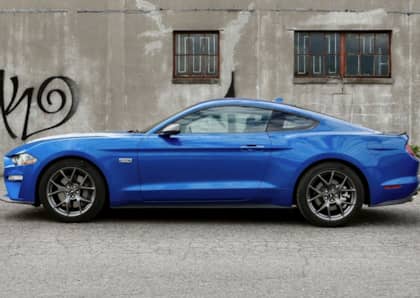Almost Pony Cars: 5 Classic 1960s Performance Machines That Offered Sub-Mustang Thrills
Right around the time the Ford Mustang made its debut in 1964, the rest of the auto industry was trying to get a handle on building small-but-fun cars. The Mustang raised the bar by creating the 'pony car' concept, and in its wake there existed a host of sub-pony machines that checked in around or just under the Ford's size, and provided their own take on the 'cheap and cheerful' concept that was about to pay off for the Blue Oval in a big way.

Although some models, like AMC's almost-entry the Tarpon, never got off the ground, others built a strong case for their inclusion in the hierarchy of classics. These five almost-pony cars predated, and in some cases were contemporaries of the Mustang that provided an inexpensive alternative for enthusiasts on a budget in the 1960s.
Chevrolet Corvair Monza Spyder / Corsa
The Chevrolet Corvair ended up a media star due to Ralph Nader's sensation 'Unsafe At Any Speed' character assassination, but all the negative hype surrounding the vehicle's safety obscured the fact that GM eventually got this hot little compact right. Introduced in 1960, by 1965 the Corvair had been given an entirely new rear suspension system, helping improve not just the rear-engine coupe and convertible's stability but also making it a more lively handler.

The first-generation Corvair offered the Spyder model for sub-pony car thrill-seekers, and this vehicle featured a 150hp, turbocharged six-cylinder engine that was a marvel of engineering that just didn't catch on with the hot rod crowd in quite the same way as small block V8s would. Second-generation cars could be had in Corsa trim, which topped out with a 180hp, 2.7-liter flat-six engine (with a naturally-aspirated version also on offer).

The Corsa left the market in 1966, but for a brief, shining moment the Corvair represented what Detroit could accomplish if given a completely clean slate and asked to design a small, and affordable, sports car.
Studebaker Lark R1 / R2
In the late 1950s the Studebaker Lark burst onto the scene as a value-focused, do-everything family of wagons, sedans, coupes, and convertibles. By the early 60s the South Bend-based automaker had decided to stuff a 289 cubic inch V8 under the hood of the Lark and make a play for budget-conscious performance fans.

Arriving in 1963, high performance Larks were split into two camps. The R1 cars featured a four-barrel carburetor feeding a 10.25:1 compression eight-cylinder motor that was good for 240hp, matched with a close-ratio four-speed manual gearbox. The R2 upped the ante with a supercharger that added an extra 49 horsepower to the mix, along with the availability of heavy duty suspension setup, a limited-slip rear differential, and bigger brakes.

Studebaker's financial foibles throughout the '60s ensured that very few R1 and R2 Larks made it into customer hands. Today, these are some of the rarest of the almost-pony cars on the collector market.
Ford Falcon Sprint
The Mustang borrowed much of its underpinnings from the Ford Falcon, a vehicle whose largely unassuming sheet metal concealed the same V8 options available to the early versions of the original pony car.

Riding on roughly the same wheelbase, the Sprint version of the 1964 Falcon featured a V8 engine as standard equipment, initially a 260 cubic inch unit that delivered 164hp and 258 lb-ft of torque. The following year, that motor (as in the Mustang) was upgraded to a 195hp version of the 289 (which also produced 282 lb-ft of torque).

The Sprint was a no-frills, basic transportation special that just happened to have a fun-to-drive V8 engine under the hood. Since it shared so much in common with the Mustang, it was able to take advantage of many of the performance parts built specifically for its sportier cousin, making it a hit for fans of low-buck drag racing as well as collectors who want to drive something different, but also cheap and easy to maintain.
Plymouth Barracuda
No, not the 'Cuda that captured hearts with Hemi madness in the 1970s, but its predecessor the Barracuda, a less extroverted and somewhat smaller sub-pony car whose first generation ran from 1964 to 1966. Although many of these fastback coupes were motivated by Plymouth's unkillable slant six engine, a 273 cubic inch V8 (180hp) was also on the order sheet.

Although primarily sold as a commuter, Plymouth gradually updated the Barracuda's performance options, adding a 235hp version of the small V8 in 1965 (particularly potent in 'Formula S' trim with its tighter suspension package).

By the time of its 1967 redesign the Barracuda's potential was fully recognized, and it became available with a full range of small block and big block Chrysler V8s—including the vaunted 426 cubic inch Hemi that would become the calling card of the third-generation cars.
AMC AMX
In the late 1960s American Motors Corporation surprised everyone by debuting a pint-size, two-seat version of its Javelin pony car called the AMX. With its ultra-short wheelbase, there was little else like the AMX on the market, and years of SCCA racing experience in Trans-Am gave AMC the tools it needed to produce a potent package for the street.

Offered from 1968 to 1970, the AMX was V8-only affair. Options ranged from a 225hp 290 cubic inch motor all the way up to a 390 cubic inch eight-cylinder that churned out 315 ponies and 425 lb-ft of twist.

More fun was on tap from the 'Go-Package,' which installed necessities like a locking differential and the kind of braking required to haul down the nose-heavy coupe at the drag strip. AMC went all-out marketing the AMX's customization potential, giving it one of the most comprehensive catalogs of hop-up parts and cosmetic accessories out of all of the era's muscle machines.











